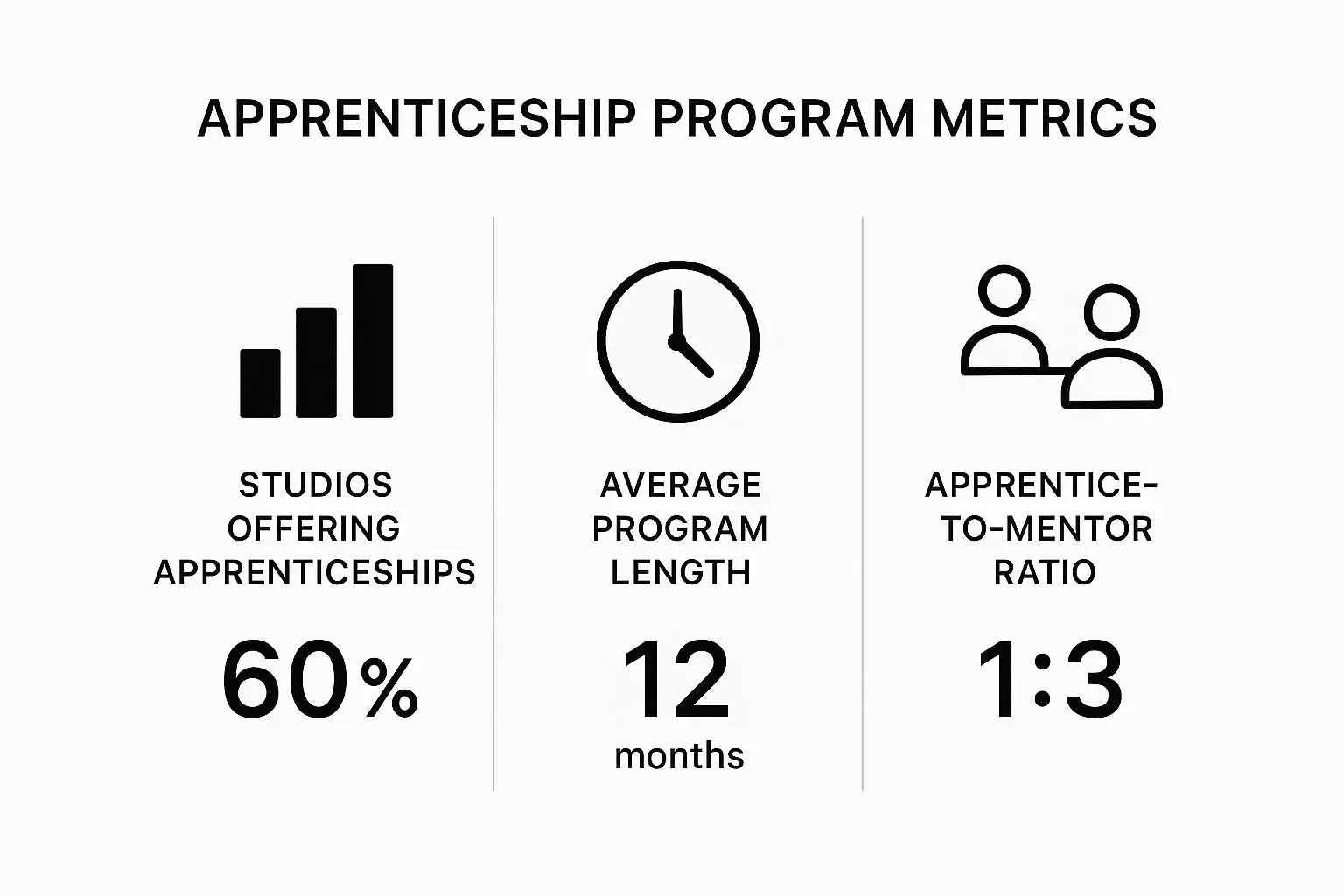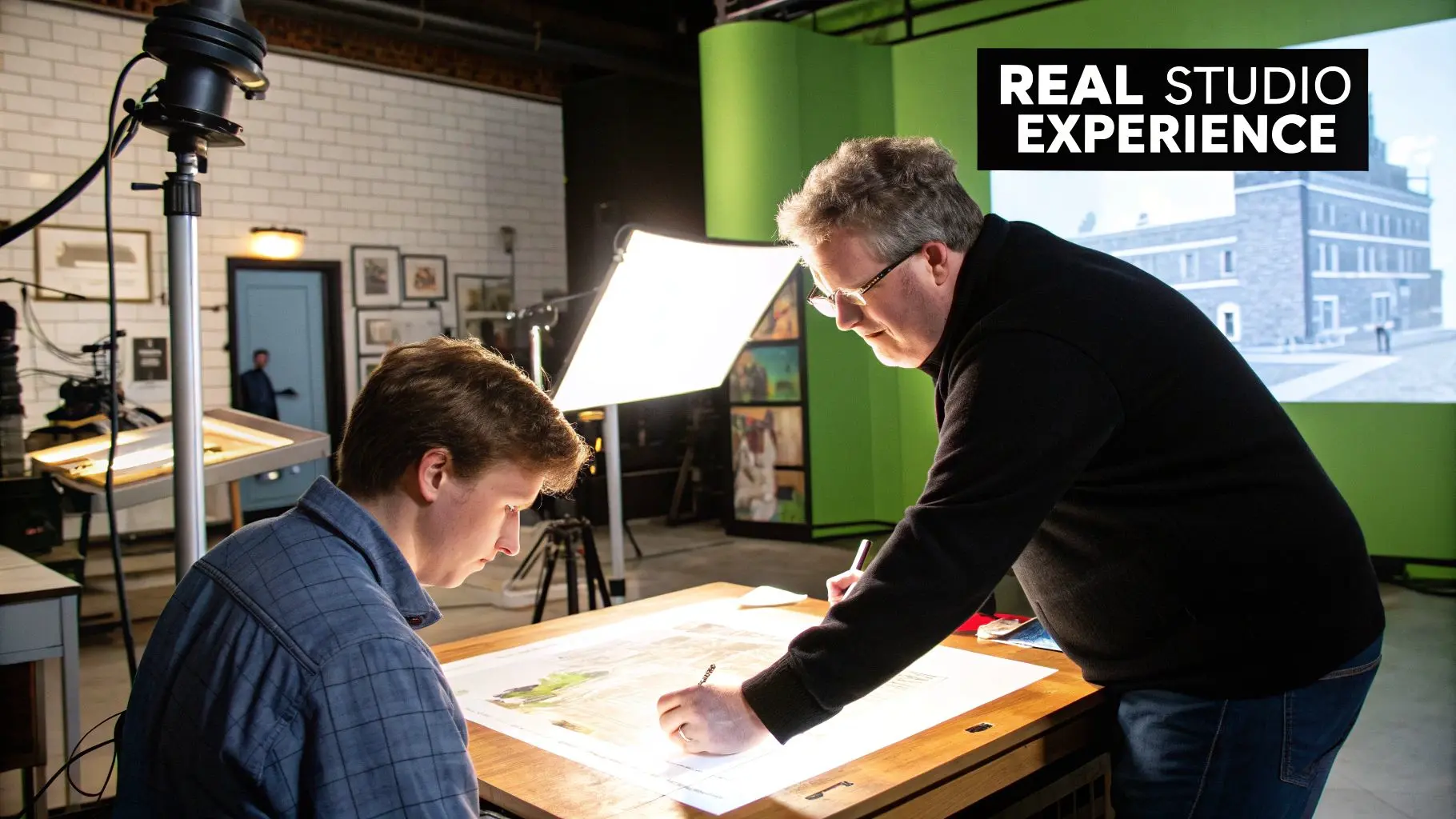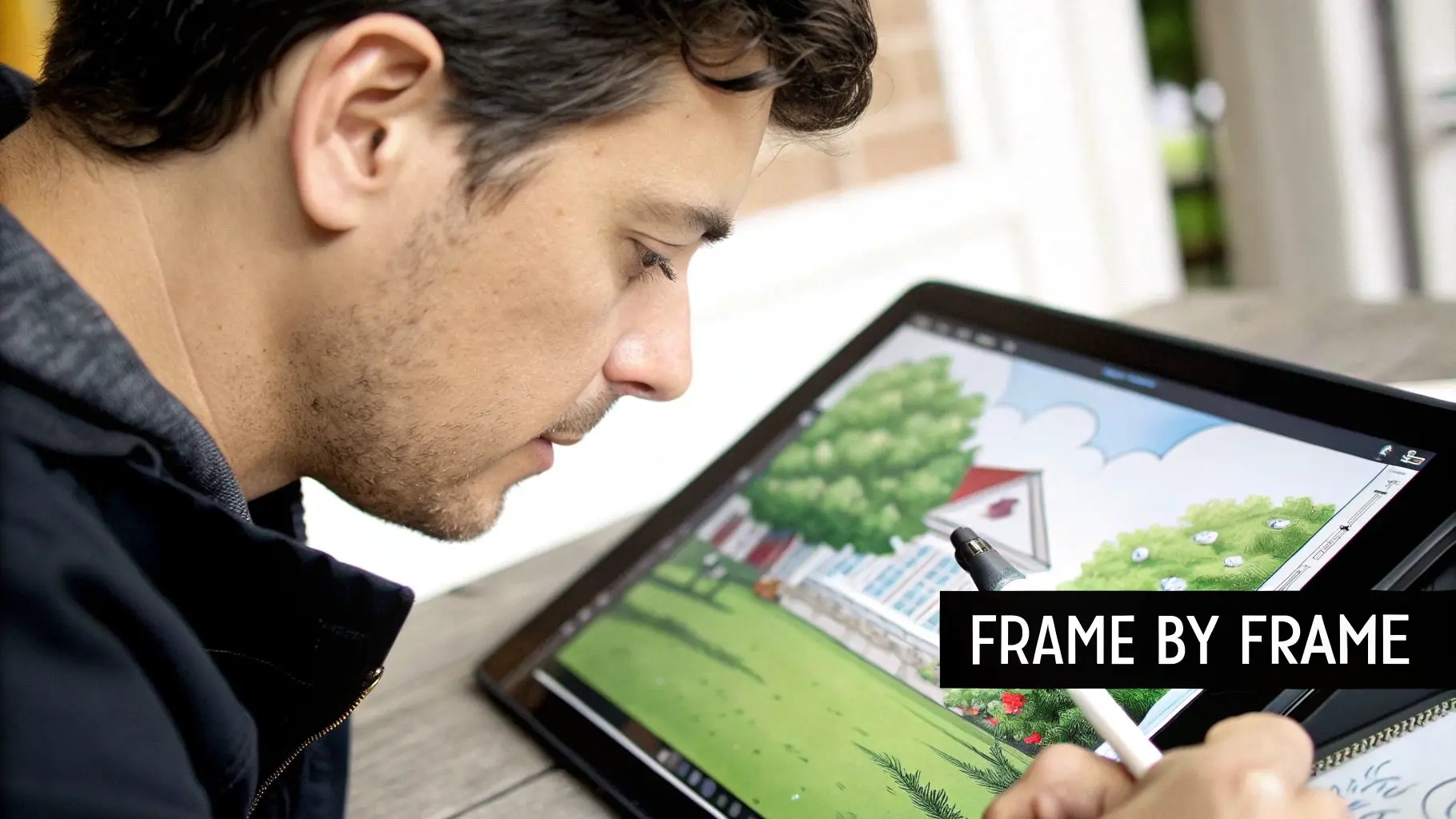Your Guide to an Apprenticeship in Animation in the UK
Think of an animation apprenticeship as the ultimate way to jump straight into the industry. It's a proper job at a creative studio, complete with a salary, that also includes structured, formal training. You literally get to earn while you learn, working on real projects and earning a nationally recognised qualification, all without racking up university debt. It’s a fast-track, hands-on way to launch your animation career.
The Modern Pathway into the Creative Industry
An animation apprenticeship is the ultimate “show, don’t tell” career starter. Instead of sitting in a lecture hall learning theory, you're dropped right into a professional studio from day one. You’re not just a student; you’re a junior team member with real responsibilities, working alongside seasoned animators and producers who become your mentors. The whole concept is brilliantly simple. You'll likely spend about four days a week getting your hands dirty on live projects, maybe helping animate a character for a kids' TV show or creating assets for a video game. The other day is dedicated to off-the-job training with a college or specialist provider, where you build the solid theoretical foundation to back up your practical skills. This blend gives you a genuine insight into studio pipelines, client feedback, and deadlines, things you just can't learn from a textbook. This infographic paints a pretty clear picture of the animation apprenticeship scene in the UK.

As you can see, it’s a supportive environment. Most studios are involved, apprentices get dedicated guidance, and the whole thing is designed to get you industry-ready in about a year.
What's The Big Difference Between an Apprenticeship and Uni?
So, how does this stack up against the traditional university route? Both paths can get you into the industry, but they are fundamentally different experiences. We've put together a quick comparison to help you see which might be the better fit for you.
Animation Apprenticeship vs University Degree At a Glance
| Attribute | Apprenticeship in Animation | University Degree |
|---|---|---|
| Learning Style | Hands-on, practical experience from day one on real commercial projects. | Primarily academic and theoretical, with practical projects in a simulated environment. |
| Cost | No tuition fees. You earn a salary while you learn. | Involves significant tuition fees and living costs, often leading to student debt. |
| Time to Qualify | Typically 12-18 months to gain a qualification and solid industry experience. | Usually 3-4 years for a Bachelor’s degree, followed by the job hunt. |
| Career Entry | You are already in the industry, building connections and a professional portfolio from the start. | You graduate and then begin the process of applying for entry-level roles. |
| Mentorship | Direct, daily mentorship from experienced industry professionals in a working studio. | Guidance from lecturers and tutors, who may have industry experience but aren't active daily. |
While a degree offers a fantastic, in-depth academic foundation, an apprenticeship throws you straight into the deep end of professional studio life. It’s a strategic choice for anyone who’s itching to start their career, learn by doing, and make a real impact from the get-go.
Key Components of an Animation Apprenticeship
This unique mix of work and study is built on a few core pillars that make it so effective:
- •Practical Experience: You're contributing to commercial projects from the moment you start, building a professional portfolio and credit list before you even qualify.
- •Mentorship: Learning directly from industry veterans gives you insights and shortcuts that would take years to figure out on your own.
- •Formal Qualification: You'll finish with a government-recognised qualification that proves your skills to future employers.
- •Earning a Salary: Getting paid for your work removes the huge financial barrier that stops many talented people from pursuing a creative career.
Whether you're drawn to the classic charm of 2D or the immersive world of 3D, this model is a direct route to mastering your craft. If you're still weighing up the styles, you can dive deeper into the differences in our guide on 2D vs 3D animation.
How UK Animation Apprenticeships Are Structured
So, what does an animation apprenticeship actually look like day-to-day? Let's pull back the curtain. Forget stuffy classrooms and endless theory; these programmes are all about practical, hands-on experience, dropping you straight into real projects from the get-go.

The most common setup is a simple but incredibly effective split. You’ll typically spend four days a week properly embedded in a studio, getting your hands dirty on live client work. This is where the real learning happens , you’ll absorb the studio's pipeline, work alongside senior artists, and see first-hand how professional animation services are delivered. The fifth day is usually set aside for your "off-the-job" training with a college or a specialist provider. This is your chance to dig into the more formal curriculum, covering the core principles and technical know-how that supports everything you're doing at the studio. It’s this dual approach that works so well, giving you both the practical chops and the recognised qualifications that studios are looking for.
Understanding the Different Levels
It's important to know that not all apprenticeships are created equal. In the UK, they’re organised into different levels, which basically line up with different educational and career stages. Think of it as a clear ladder you can climb.
- •Level 3 (Advanced Apprenticeship): This is a brilliant entry point, often seen as equivalent to A-Levels. You might land a role like a Junior 2D Animator or Production Runner, where you’ll learn the absolute fundamentals of the craft.
- •Levels 4 & 5 (Higher Apprenticeship): Stepping it up a notch, these are comparable to a foundation degree or the first year of a university course. Roles here, like an Assistant Technical Director or Junior Rigger, demand a bit more specialised knowledge.
- •Levels 6 & 7 (Degree Apprenticeship): This is the top tier, matching a full Bachelor's or even a Master's degree. These are highly competitive spots for people aiming for those senior creative or technical positions down the line.
This structured progression is really catching on. In fact, data for the 2024/25 academic year shows an 11% rise in higher apprenticeship starts (that's Levels 4, 7), with degree-level apprenticeships jumping by 13%. It’s a clear sign that the industry is crying out for these advanced, work-based skills. You can dive deeper into these trends in the latest government statistics.
What Does This Mean for You? The entire apprenticeship framework is designed by industry experts, for the industry. It means you aren't learning outdated techniques from a textbook. You are mastering the exact software, pipelines, and collaborative workflows that top studios are using right now.
The whole point is to mould you into an indispensable part of the team. By the time you finish, you won’t just walk away with a certificate. You’ll have a portfolio packed with professional work, a network of industry contacts, and the genuine confidence to take that next big step in your animation career.
Gaining an Edge with an Apprenticeship
Why are so many aspiring animators looking at apprenticeships instead of the more traditional routes? It turns out the benefits go way beyond just earning a salary. Choosing an apprenticeship in animation is a serious strategic move, giving you a powerful head start in what's a very competitive industry.

The biggest and most obvious advantage is financial. You’re kicking off your career without the huge weight of student debt, which can be a massive relief. It lets you focus completely on your craft and professional growth, not on how you're going to pay back loans. You’re building savings and financial independence from day one. Beyond the money, you gain something truly priceless: years of professional experience. While your mates are sitting in lecture halls, you’re in a studio, getting your hands dirty on live projects. You’re building a portfolio packed with real, commercial work. This is the stuff that genuinely sets you apart when it’s time to land future roles.
Building Your Network and Soft Skills
An apprenticeship throws you right into the professional world, where you start building a network of industry contacts almost by accident. The senior animator mentoring you, the production coordinator you grab coffee with, the clients you sit in on meetings with, they all become part of your professional circle. These connections are gold dust and can open doors for you throughout your entire career. What's more, you’re learning all the essential soft skills that you just can't pick up in a classroom. These are the abilities that make you a great team member and a pro people want to work with again.
- •Navigating Client Feedback: You’ll quickly learn how to take creative notes and turn them into constructive changes, a vital skill for any commercial artist.
- •Meeting Tight Deadlines: You'll get a feel for the pace of a real studio, learning to manage your time effectively when the pressure is on.
- •Working in a Creative Team: You’ll see how a production pipeline really works, learning to communicate clearly and play your part in a shared creative vision.
An apprenticeship isn’t a shortcut; it's a smarter, more direct route into the heart of the animation industry. It equips you not just with technical skills, but with the professional resilience, communication abilities, and industry connections needed to build a sustainable and successful career from the very beginning.
Ultimately, this path is about much more than just finding a job. It’s about embedding yourself in the industry's culture and workflow before many of your peers have even started looking. By the time you qualify, you're not just a graduate with a certificate; you're an experienced animator with a proven track record, a professional network, and a portfolio full of real-world work. That combination gives you a massive edge in a field where experience is king.
What Studios Look for in an Apprentice
Getting your foot in the door for an animation apprenticeship is about more than just raw artistic talent. Of course, a strong portfolio is your ticket to the dance, but studios are playing the long game, they're investing in your potential. They’re looking for someone who has the foundational skills, a great attitude, and a genuine hunger to learn and grow as part of a creative team.

Try to see it from their side for a second. They're about to commit serious time, money, and mentorship to you. A collaborative spirit and raw potential often count for more than being a lone genius. They need to know you can take direction, handle constructive feedback without getting defensive, and genuinely add to the studio's culture.
The Essential Skills Checklist
Every studio is a little different, but there are a few core skills and qualities that hiring managers always have on their radar. Before you fire off that application, do a quick self-check against this list.
- •A Compelling Portfolio: This is your creative CV, the first thing anyone will look at. It needs to showcase your best work, but more than that, it has to scream potential. Pack it with life drawings, character sketches, and short animation tests. And don't just show the polished final product, including some of your process work gives them a peek into how you think.
- •Software Proficiency: You don't need to be a master of every tool under the sun. Instead, get a really solid handle on one or two industry-standard programs. Whether it's Maya, Blender, Toon Boom Harmony, or something from the Adobe Creative Suite (like After Effects or Animate), prove you know your way around.
- •A Hunger to Learn: This one is absolutely non-negotiable. Studios want apprentices who are naturally curious, ask smart questions, and are always looking to absorb new knowledge. Your enthusiasm can be your single greatest asset.
- •Collaboration and Communication: Let's be clear: animation is a team sport. You’ve got to be able to explain your ideas clearly and work smoothly with everyone, from the lead animator to the production coordinator.
In the UK's animation sector, an impressive 93% of workers hold a university degree. Even so, the industry knows that nothing beats hands-on experience. Apprenticeships are seen as the vital bridge between academic theory and the practical realities of a busy studio. You can find more insights on this from Animation UK's report on the workforce.
Standing Out from the Crowd
Ticking all those boxes will get you noticed, but a few extra qualities can make you the candidate they just can't say no to. Resilience is a big one. You'll be up against tight deadlines and tough feedback, so showing you can take a hit and bounce back is a massive plus. It also pays to do your homework. Research the studio you’re applying to and tailor your application to them specifically. Mention a project of theirs that you loved and explain why it inspired you. A little bit of genuine interest goes a long way. Taking a look through a studio’s back catalogue, like the projects in our work portfolio, gives you a real feel for their style and pipeline. It's a small step, but it shows initiative and passion, two things every creative team is desperate for.
Finding and Applying for Animation Apprenticeships
So, you’re ready to jump into an apprenticeship in animation? Fantastic. Knowing where to look is half the battle, and your best bet is to start with official, industry-recognised platforms. They’re the most reliable places to find legitimate opportunities. The UK government's official 'Find an apprenticeship' portal should be your first port of call. Think of it as the central station for every approved scheme in the country, not just for animation but for all creative sectors. You can filter by location, industry, and level, making it a seriously powerful tool for your search. Alongside government sites, you absolutely need to get familiar with industry-specific bodies. Organisations like ScreenSkills are the lifeblood of the UK’s screen industries, and they regularly list training and apprenticeship vacancies built specifically for animation, VFX, and games. It’s also a great habit to bookmark the careers pages of studios you love. Big animation houses often post openings on their own websites before they go anywhere else.
Preparing Your Application
Right, you’ve found an opening that looks perfect. Now you need to make sure your application makes a real impact. A generic CV just won't fly in the creative world; you need to prove you understand the industry inside and out.
- •Tailor Your CV and Cover Letter: Ditch the 'one-size-fits-all' approach for good. For every single application, read the job description carefully and highlight the specific skills and software they’re asking for. Your cover letter is where you let your passion shine, mention a project the studio created that inspired you and, crucially, explain why.
- •Curate a Killer Portfolio: Your portfolio is your secret weapon. It’s not just about showing off; it's about showcasing your potential. Make sure to include life drawings, character sketches, and short animation tests that prove you’ve got a solid grasp of the core principles of animation. Remember, quality over quantity, always.
The apprenticeship world is getting more competitive. In 2023, there were roughly 63,050 apprenticeship vacancies advertised across the UK, which was a noticeable dip from the year before. This just goes to show how important a polished, standout application really is. You can dig into more UK apprenticeship trends on standout-cv.com.
Nailing the Interview
If your application does the trick, the final hurdle is the interview. Try not to see it as a test. It's really more of a conversation to see if you’ll be a good fit for the team's culture and workflow. Be ready to walk them through your portfolio, explain your creative process, and talk about what you're genuinely excited to learn. More than anything, let your enthusiasm for animation pour out. Studios aren't just hiring an apprentice; they're investing in a future artist. Show them you’re eager to learn, ready to work hard, and excited to become a valuable part of their creative family.
Your Career Path After an Apprenticeship
Think of finishing your apprenticeship in animation not as crossing the finish line, but as getting into the starting blocks for a long and exciting career. You’ve just spent more than a year deep inside a studio, proving your skills, your commitment, and your worth. To them, you’re not a stranger with a showreel; you’re a known quantity with a solid track record. The most natural next step? Moving into a full-time, permanent role right where you trained. It happens a lot. Studios invest a huge amount of time and energy into their apprentices, so it just makes good business sense to keep that talent on the team. After all, you already know the people, the pipeline, and the studio’s unique way of doing things.
Climbing the Career Ladder
Once you've landed that first junior role, the path forward starts to look much clearer. Your time as an apprentice has given you a massive head start, often letting you climb the ladder much quicker than many graduates who are just finding their feet in a professional environment. A typical career path might unfold something like this:
- •Junior Animator/Artist: This is where you'll really sharpen your craft. You’ll be working on all sorts of projects, taking on bigger and more complex tasks with the support of senior artists.
- •Mid-Level Animator/Artist: A few years in, you’ll be much more independent. You might be trusted with key scenes or even start mentoring the next wave of apprentices coming through.
- •Senior or Lead Roles: With a portfolio of proven work, you could step up to a Lead Animator, Lead Rigger, or Senior Compositor. This means you’ll be looking after a small team and taking ownership of major parts of a project.
- •Supervisory or Management Roles: Look further down the road, and roles like Animation Supervisor or Production Manager are well within reach. This is where you get to shape the creative and practical direction of entire shows.
The professional network you forge during your training is one of your biggest assets. The mentors you learn from and the colleagues you work alongside will become your champions, your references, and your future connections for years to come.
An apprenticeship doesn't just train you for a job; it plugs you directly into the industry’s ecosystem. It gives you the skills, the real-world experience, and the vital connections you need to not just start your career, but to build a lasting and successful one in the UK's buzzing animation scene.
Still Have a Few Questions?
Let's tackle some of the most common questions that pop up when people start looking into animation apprenticeships. Getting these final details ironed out should give you a clearer picture of what to expect.
What Sort of Salary Can I Expect as an Apprentice in the UK?
This is a big one, of course. In the UK, there's a National Minimum Wage for apprentices, which sits at £6.40 per hour as of April 2024. But here’s the thing , that's just the baseline. Most animation studios, particularly in creative hubs like London, Manchester, or Bristol, know they need to offer more to bring in promising talent. It’s very common for them to pay a good deal more than the minimum. You'll also find that your pay will likely increase as you progress through the programme, picking up new skills and taking on more important tasks.
Do I Absolutely Need a University Degree to Get In?
Nope, not at all. In fact, that’s one of the best things about apprenticeships. They’re built to be a direct alternative to the traditional university route. Studios are far more interested in your portfolio, your raw potential, and your passion for animation than they are in your academic certificates. While some of the more advanced degree-level apprenticeships might ask for A-Levels or something similar, the focus is always, always on your creative skills and drive.
Can I Focus on a Specific Area of Animation?
Yes, and this is becoming more and more common. While you'll definitely see generalist 'Junior Animator' apprenticeships, many studios now offer specialised programmes that slot you directly into a specific part of the production pipeline. You could find yourself diving deep into areas like:
- •3D Modelling: Bringing characters, props, and entire worlds to life.
- •Rigging: Creating the digital skeletons and control systems that animators use to make characters move.
- •Visual Effects (VFX): Blending computer-generated imagery seamlessly with live-action film.
- •Motion Graphics: Designing animated logos, dynamic titles, and slick explainer videos.
My advice? Always read the job description inside and out. It’ll tell you exactly what the studio is looking for and where you’ll be concentrating your training. At Studio Liddell, we’re passionate about bringing through the next wave of creative talent. Our team has been crafting award-winning animation and immersive experiences since 1996. Explore our services and see what a career in a leading studio looks like. Article created using Outrank